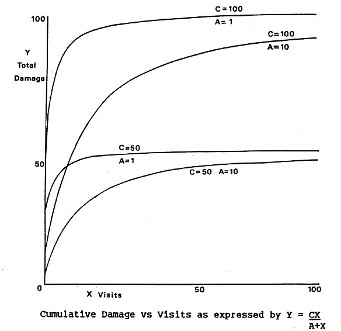WILDERNESS CAVE CARRYING CAPACITY
The title of this paper is a misnomer. The term carrying capacity when applied to wilderness cave management is inappropriate and misleading. In an article, 'Caves, Cows and Carrying Capacity', Thomas Aley observes that the term carrying capacity and the rationale that it exists derive from rangeland management. In rangeland management, he points out, it is likely that your animals will eat the grass (renewable resources) before damaging the soil (non-renewable resources). Within caves it is often the essentially non-renewable resources, delicate formation, sensitive cave biota and the like that are damaged before renewable resources. Paradoxically as the susceptible non-renewable resources are lost and the cave's susceptibility to damage decreases so the carrying capacity of the cave will increase. Aley notes "such a relationship can be an effective deterrent to cave management and protection".
Aley's criticism is not an entire justification for dismissing carrying capacity. Recreational carrying capacity has been refined and redefined away from that original rangeland definition. Generally recreational carrying capacity is used in two ways; it is an expression of the ability of the physical-biological environment to withstand recreational use or it can be used to express the amount of use that is compatible with some measure of quality in the recreational experience. Obviously visitor satisfaction will be at least partially related to the condition of the environment. However there is a component - psychological carrying capacity - which relates to the effect of other peoples presence on the experience of a visitor to the wilderness and can be summed up in the truism that many people cannot enjoy solitude together. I argue that it is only in a limited psychological sense that the concept of capacity is truly applicable to caves. Painstakingly the relevance of each aspect of recreational carrying capacity would be possible but not very productive. Instead I shall be proposing a conceptual relationship between impact and use in a cave environment. Above ground carrying capacity makes two implicit assumptions:
- the environment has the capacity to regenerate within a management time frame.
- man can affect the character of change and the rate of change and such change is not necessarily damage.
I assume that the cave environment seldom has powers of regeneration and that almost all change will be damage. In caves the following relationship is likely to hold:

Figure 1: Cumulative Damage vs Visits as expressed by Y = (CX) / (A+X)
X is the number of visits. Y is cumulative damage. C is a constant relating to the susceptibility of the cave to damage and is the maximum damage that may occur. The value of C will vary from cave to cave and may be reduced by making some damage effectively impossible. Totally barring access to a portion of cave would achieve this. A is a constant relating to the rate of damage. The lower the value of A the greater the initial rate of damage. The value of A may be increased by hardening the environment, educating the user or changing the type of user.
Such a relationship is purely conceptual at present. Nevertheless it is useful to think in terms of the framework given by the above curves in that they separate:
- the rate of deterioration
- the final state of the cave
It can be seen that it would be possible to work out a kind of use-limit on this basis by determining how much damage is permissible over a particular length of time and then referring to the graph to determine how much use is acceptable the use limit will be a variable. The more susceptible and less visited a cave system is, the lower will be the use-limit. This use-limit is the closest equivalent caves can have to carrying capacity, Accepting this should mean a concentration on controlling the rate of damage per visit and the total damage possible rather than controlling to a level of damage as an above ground rationale would have us do. Tourist cave management regulates the total damage possible by effectively denying access to portions of cave by regulation of use and site management. Wilderness cave management will be primarily directed at the rate at which damage occurs.
In terms of the total cave resource the model suggests that where possible recreational use should be concentrated on particular caves for otherwise dispersed use may mean a relatively profound deterioration in numerous caves rather than an extreme deterioration in only a few. If caves are to be chosen for novice cavers or adventure cave tours then it is best that these caves possess only a light potential damage curve whether through past use and consequent damage, or through being naturally robust. Such caves have been referred to as sacrificial - but this is a misleading term. The "sacrifice" can only amount to the damage left to be done. In many instances this will be virtually no "sacrifice". Oddly enough such caves often have high aesthetic and wilderness values.
At the other end of the spectrum are caves which should receive as little use as possible for use will inevitably mean unacceptable degradation.
The relationship I have suggested is purely conceptual. To recognise the possible shape of a caves damage curve it is important to be able to accurately assess and understand use and impact. Programmes of monitoring both are an obligation of any serious wilderness management.
REFERENCES
ALEY, T. Caves, Cows, and Carrying capacity. NSS News 4(7):133-34, 1976.